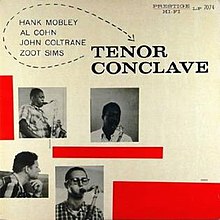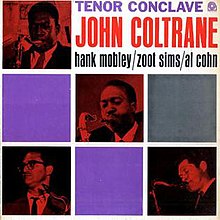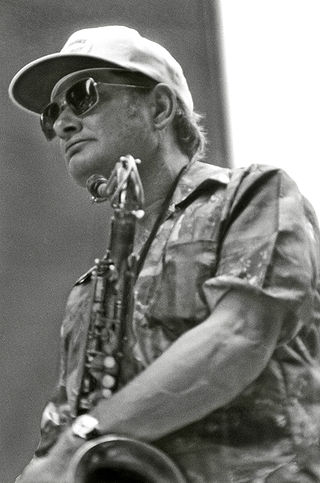
John Haley "Zoot" Sims was an American jazz saxophonist, playing mainly tenor but also alto saxophone. He first gained attention in the "Four Brothers" sax section of Woody Herman's big band, afterward enjoying a long solo career, often in partnership with fellow saxmen Gerry Mulligan and Al Cohn.

Henry Mobley was an American tenor saxophonist and composer. Mobley was described by Leonard Feather as the "middleweight champion of the tenor saxophone", a metaphor used to describe his tone, that was neither as aggressive as John Coltrane nor as mellow as Lester Young, and his style that was laid-back, subtle and melodic, especially in contrast with players such as Coltrane and Sonny Rollins. The critic Stacia Proefrock claimed him "one of the most underrated musicians of the bop era." Mobley's compositions include "Double Exposure", "Soul Station", and "Dig Dis".

Sonny Stitt was an American jazz saxophonist of the bebop/hard bop idiom. Known for his warm tone, he was one of the best-documented saxophonists of his generation, recording more than 100 albums. He was nicknamed the "Lone Wolf" by jazz critic Dan Morgenstern because of his tendency to rarely work with the same musicians for long despite his relentless touring and devotion to the craft. Stitt was sometimes viewed as a Charlie Parker mimic, especially earlier in his career, but gradually came to develop his own sound and style, particularly when performing on tenor saxophone and even occasionally baritone saxophone.

'Round About Midnight is a studio album by the jazz trumpeter and composer Miles Davis with his quintet. It was released through Columbia Records in March 1957, and is Davis's first record on the label. The recording took place at Columbia's New York studio in three sessions between October 1955 and September 1956.
Wilbur Bernard Ware was an American jazz double bassist. He was a regular bassist for the Riverside record label in the 1950s, and recorded regularly in that decade with Johnny Griffin, Kenny Dorham, Kenny Drew, and Thelonious Monk. He also appeared on records released by J.R. Monterose, Toots Thielemans, Sonny Clark, Tina Brooks, Zoot Sims, and Grant Green, among others.

Al Cohn was an American jazz saxophonist, arranger and composer. He came to prominence in the band of clarinetist Woody Herman and was known for his longtime musical partnership with fellow saxophonist Zoot Sims.

James "Osie" Johnson was a jazz drummer, arranger and singer.

Settin' the Pace is a studio album by the jazz musician and composer John Coltrane. It was released in December 1961 through Prestige Records. It is assembled from previously unissued tracks from a recording session at the studio of Rudy Van Gelder in Hackensack, New Jersey in 1958. Coltrane on tenor saxophone is accompanied by Red Garland on piano, Paul Chambers on bass, and Art Taylor on drums. With Garland and Chambers, Coltrane had played together since at least October 1955 in Miles Davis' band. With Art Taylor they were part of the Tenor Conclave recordings in September 1956. As a quartet they had already recorded two albums for Prestige, John Coltrane with the Red Garland Trio and Soultrane. The material the quartet recorded on this session were extended interpretations of three popular songs and "Little Melonae", a classic bebop tune written by Jackie McLean. Of note is Coltrane's use of the sheets of sound technique, particularly on "Little Melonae".

Informal Jazz is an album by jazz musician Elmo Hope, released in September or October 1956 on Prestige Records. It was reissued in 1969 under the title Two Tenors, and under the billing of Hope's sidemen for the session, John Coltrane and Hank Mobley.

Trane's Blues is a compact disc credited to the jazz musician John Coltrane, released in 1999 on Blue Note Records, catalogue 98240. It comprises recordings from sessions for Blue Note and United Artists Records with Coltrane as a sideman for Paul Chambers, Sonny Clark, Johnny Griffin, and Cecil Taylor. These recordings were issued respectively on their Whims of Chambers, Sonny's Crib, A Blowin' Session, and Hard Driving Jazz albums. Two selections are from Coltrane's own 1957 Blue Train, and "One and Four" had been previously unissued. "Trane's Blues" had been issued on the compilation High Step in 1975, previously known as "John Paul Jones" and named after himself, the bass player Chambers, and the drummer Philly Joe Jones. Like Prestige Records before them, as Coltrane's fame grew long after he had stopped recording for the label, Blue Note used varied recordings, often those where Coltrane had been merely a sideman, and reissued them as a new album with Coltrane's name prominently displayed. In this case, the Big Four conglomerate EMI continued that earlier practice.

Interplay for 2 Trumpets and 2 Tenors is a jazz album released in November 1957 by Prestige Records. It is credited to Idrees Sulieman, Webster Young, John Coltrane and Bobby Jaspar, with Mal Waldron, Kenny Burrell, Paul Chambers and Art Taylor.

Johnny Griffin, Vol. 2, also known as A Blowing Session, is an album by the jazz saxophonist Johnny Griffin. It was recorded in April 1957 and released in September or October the same year through Blue Note Records.
"How Deep Is the Ocean?" is a popular song written by Irving Berlin in 1932. The song was developed from an earlier Berlin song "To My Mammy" which was sung by Al Jolson in his film Mammy (1930). In the earlier song, the lyrics include the questions "How deep is the ocean? / How high is the sky?" and this was the genesis of "How Deep Is the Ocean?".

The Complete Columbia Recordings of Miles Davis with John Coltrane is a box set featuring jazz musicians Miles Davis and John Coltrane. It is the first box set in a series of eight from Columbia/Legacy compiling Davis's work for Columbia Records, and includes never-before-released alternate takes, omissions of other musicians, musician comments, false starts and a first version of compositions, some of which have made it to the 50th Anniversary 2-disc CD version of Kind of Blue. Originally issued on April 11, 2000, in a limited-edition metal slipcase, it was reissued in 2004 in an oversized book format. In conjunction with Sony, Mosaic Records released the 9-LP set.

Miles Davis and Horns is a compilation album by the American jazz trumpeter Miles Davis. Released in 1956, by Prestige Records, it compiles material from albums previously released by Prestige in the discontinued 10 inch LP format. The fifth, sixth, and eighth tracks were originally issued on the various artists album Modern Jazz Trumpets, and had also been issued as 78rpm singles. Tracks 1–4 first appeared on Miles Davis Plays The Compositions Of Al Cohn. Track 3 was also previously released as the B-side of the "Morpheus" single. Track 7 was originally on Blue Period.
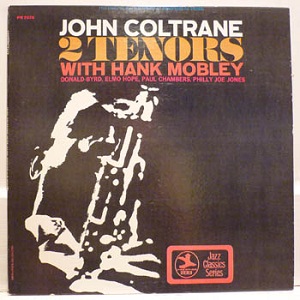
Two Tenors is an album credited to jazz musicians John Coltrane and Hank Mobley, released in 1969 on Prestige Records, catalogue 7670. It is a reissue of Prestige 7043 Informal Jazz by Elmo Hope, released in 1956. As Coltrane's fame grew during the 1960s long after he had stopped recording for the label, Prestige assembled varied recordings, often those where Coltrane had been merely a sideman, and reissued them as a new album with Coltrane's name prominently displayed. In this case, by 1969 Hope had become a far less marketable figure than Coltrane and Mobley, hence the redesignation of the LP.

Whooeeee is an album by the Zoot Sims-Bob Brookmeyer Quintet recorded in 1956 for the Storyville label.
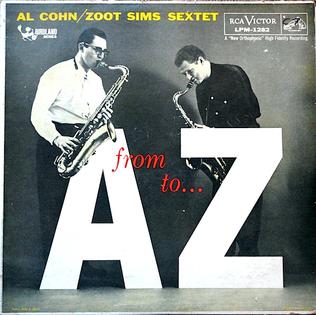
From A to...Z is an album by the Al Cohn/Zoot Sims Sextet recorded in early 1956 for the RCA Victor label.
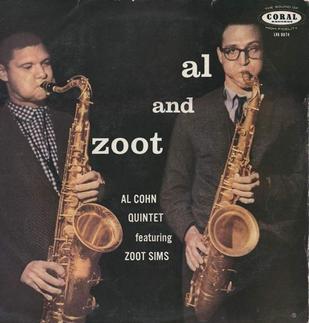
Al and Zoot is an album by the Al Cohn Quintet featuring Zoot Sims recorded in 1957 for the Coral label.

The Brothers is a studio compilation album by American saxophonists Stan Getz and Zoot Sims released in 1956 via Prestige label.
